Children in migration - asylum applicants
Data extracted 23 April 2024
Planned article update: April 2025
Highlights
254 900 first-time asylum applicants were children, representing 24.3 % of the total number of first-time asylum applicants recorded in the EU, in 2023.
Syrians (22.4 %) and Afghans (13.1 %) were by far the most represented citizenships of first-time asylum applicant children in the EU in 2023.
The percentage of positive decisions on asylum applications was higher for children than for adults over the period from 2013 to 2023.
In 2023, unaccompanied minor applicants accounted for 17.0 % of the total number of first-time asylum applicants aged below 18.
Number of first-time asylum applicants aged less than 18 years old in the EU, 2013-2023
Among all migrants, children are a particularly vulnerable group requiring special care. Based on available asylum data, this article focuses on developments over the period from 2013 to 2023 of one of the main components of the immigration of children in the European Union (EU) and in EFTA countries: the number of first-time asylum applicants aged less than 18 years old. Asylum statistics collected by Eurostat are based on information from administrative events related to the asylum procedure (applications and decisions).
Full article
Main features at EU level in 2023
In 2023, the total number of first-time asylum applicants under the age of 18 in the EU was 254 900 persons. When comparing this figure with the total EU population aged less than 18, it corresponds to 3.2 first-time applicant children per 1 000 children resident in the EU. Figure 1 also shows that 120 915 children received protected status in 2023 while the asylum applications of 21 330 children were rejected in the final instance. At the end of 2023, 244 960 children were awaiting a decision on their asylum application in the EU.

Figure 1: Children (persons under 18 years old) in migration in the EU in 2023
(number)
Source: Eurostat (migr_asyappctza), (migr_asydcfsta), (migr_asydcfina) and (migr_asypenctzm)
Figure 2 provides some insights into the characteristics of first-time asylum applicant children for the year 2023: children account for 24.3 % of the total number of first-time asylum applicants in the EU, the majority are male (58.6 %) and 17.0 % of them are unaccompanied minors.

Figure 2: Main characteristics of the first-time asylum applicants aged less than 18 in the EU in 2023
(%)
Source: Eurostat (migr_asyappctza) and (migr_asyumacta) and (migr_asyunaa)
Development from 2013 to 2023
Figure 3 shows the trend over the past ten years of the number of first-time asylum applicant children. The number of first-time asylum applicants aged less than 18 years rose until the peak of the “migration crisis” in 2016. From 2016 onwards, a downward trend is observed with a minimum value in 2020 (it should be taken into account that the drop observed in 2020 may be mostly explained by the COVID-19 outbreak and the related introduction of movement restrictions and border closures). The number of first-time asylum applicant children increased again from 2021. In 2023, 254 900 children applied for asylum in EU countries for the first time and it was the highest number since 2016. Over the period from 2013 to 2023, 2.3 million children lodged an asylum application in the EU.
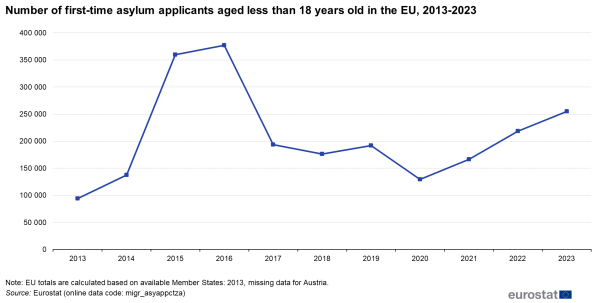
Figure 3: Number of first-time asylum applicants aged less than 18 years old in the EU, 2013-2023
Source: Eurostat (migr_asyappctza)
When looking at the breakdown by EU countries (Table 1), the main destination in the EU of first-time asylum applicant children over the whole period from 2013 to 2023 was Germany (45.4 %) followed by France (11.0 %) and Sweden (6.6 %). In 2023, Germany (40.6 %) and France (15.1 %) still remained the two main destinations for first-time asylum applicant children, followed by Spain (12.0 %).

Table 1: First-time applicants aged less than 18 years old in the European Union and in the Member States, 2013-2023
(number)
Source: Eurostat (migr_asyappctza)
Figure 4 compares the breakdown by EU country observed over the period from 2013 to 2023 and in 2023. The main features are: the increase in the share recorded in 2023 for Spain, France and Austria and the decrease observed in Hungary, Germany and, to a greater extent, Sweden.
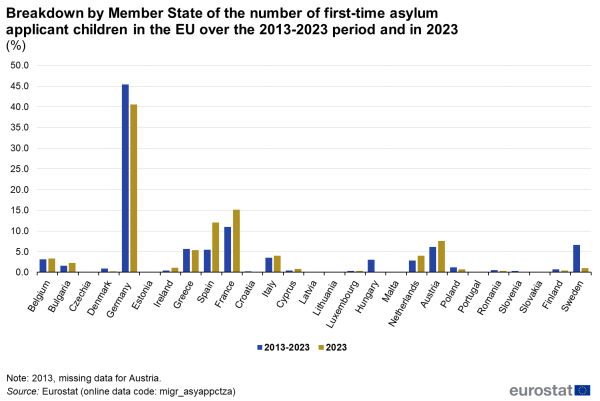
Figure 4: Breakdown by Member State of the number of first-time asylum applicant children in the EU over the 2013-2023 period and in 2023
(%)
Source: Eurostat (migr_asyappctza)
In order to compare the development of the number of first-time asylum applicants aged less than 18, Figure 5 shows the number of first-time asylum applicant children relative to the population aged less than 18 years old.
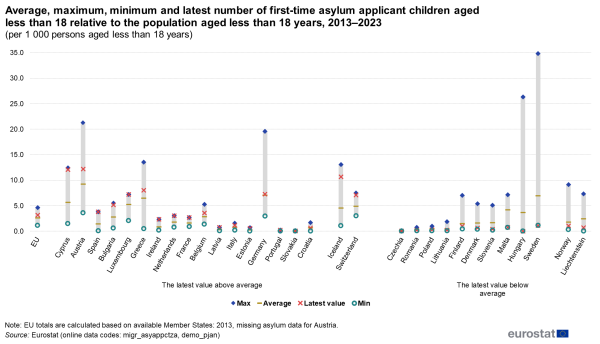
Figure 5: Average, maximum, minimum and latest number of first-time asylum applicant children aged less than 18 relative to the population aged less than 18 years, 2013–2023
(per 1 000 persons aged less than 18 years)
Source: Eurostat (migr_asyappctza) and (demo_pjan)
In Figure 5, the dark blue square marker shows the highest (maximum) value of the ratio of the number of first-time asylum applicant children aged less than 18 relative to the population aged less than 18 years for any year from 2013 to 2023; the lowest (minimum) value is indicated by the green circular marker. The distance between these two markers (shown by the vertical grey bar) indicates the range observed over the whole period. The differences between the maximum and minimum values recorded between 2013 and 2023 were the largest in Sweden, Hungary, Austria and Germany.
Figure 5 also includes a red cross marker to show the latest value of the same ratio and a gold line for the average from 2013 to 2023. Within the figure, the EU countries and EFTA countries have been classified in two groups, depending on whether their latest value for this ratio lies above or below their average for 2013 to 2023; within these two groups they have been ranked according to the average value. Most of the EU countries are in the first group, indicating that the latest value of the ratio was above the average from 2013 to 2023. The reverse was observed for ten EU countries, most notably in Sweden, Hungary and Malta.
Citizenship of first-time asylum applicant children
Table 2 presents the geographical breakdown by the 20 main citizenships of first-time asylum applicants aged less than 18 for the period 2013 to 2023 and for the year 2023. Over the whole period the three main citizenships of first-time asylum applicant children were Syrian, Afghan and Iraqi. The weight of these three citizenships was equal to 49.6 % of the total of first-time asylum applicants aged less than 18 years over the 2013-2023 period. Syrians and Afghans were also the most represented citizenships of first-time asylum applicant children in the EU in 2023. They were followed by citizens of Türkiye.

Table 2: Top 20 citizenships of first-time asylum applicants aged less than 18 in the EU over the 2013-2023 period and in 2023
(number and share in the total)
Source: Eurostat (migr_asyappctza)
Figure 6 shows the development by main geographical area. Up until 2014, Asia and Europe followed a comparable trajectory. The “migration crisis” illustrated by the peak observed for Asia in 2015 and 2016 interrupted this similarity, even if the maximum number of first-time asylum applicant children having European citizenship (non-EU) was recorded in 2015. After those peaks, Asian and European curves are characterised by a downward trend until 2020, and again an upward trend in 2021 to 2023. Concerning Africa, a regular upward trend can be seen until 2017 before fluctuating during the past five years. Starting in 2017, more first-time asylum applicant children were citizens of an African country than a European one. Lastly, the number of first-time asylum applicant children who are citizens of an American country significantly increased from 2016 to 2019, surpassing the number recorded for European (non-EU) child citizens in 2020, but the drop observed in 2021 changed this pattern.

Figure 6: Number of first-time asylum applicants aged less than 18 in the EU by main geographical areas, 2013-2023
Source: Eurostat (migr_asyappctza)
First-time asylum applicant children by sex
Figure 7 shows the development of the share of males in the total number of first-time applicants aged less than 18. Over the whole period, the share of males for first-time applicant children is significantly higher than 50 %, with a minimum of 54.1 % observed in 2019 and a maximum of 64.2 % in 2015, whereas the average value over the period from 2013 to 2023 was equal to 58.6 %.
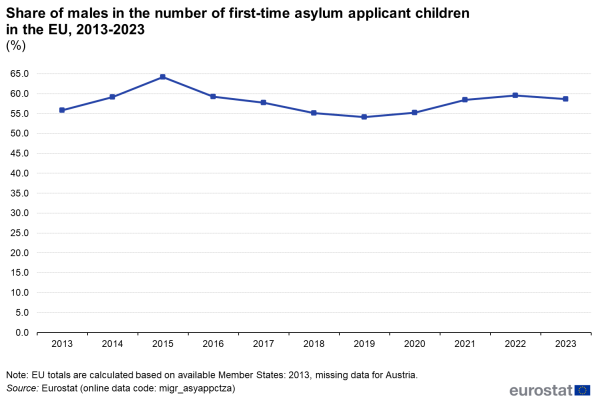
Figure 7: Share of males in the number of first-time asylum applicant children in the EU, 2013-2023
(%)
Source: Eurostat (migr_asyappctza)
As can be seen in Figure 8, the share of children in the total number of first-time asylum applicants is not stable over time, ranging between 24 % and 32 %. One of the main features is that the share of children increased during the “migration crisis” and remained over 30 % until 2021. In 2023, the share of children in the total number of first-time asylum applicants dropped to 24.3 % and was the lowest over the whole period analysed.
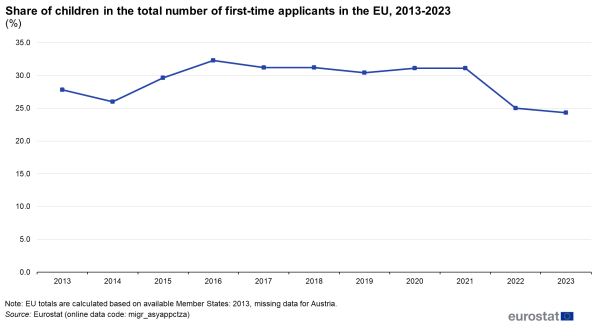
Figure 8: Share of children in the total number of first-time applicants in the EU, 2013-2023
(%)
Source: Eurostat (migr_asyappctza)
Figure 9 shows the share of children in the total number of first-time asylum applicants by Member State in 2023. In 11 EU countries the share was above the EU average, with the highest values observed in Austria (34.7 %), Luxembourg (34.4 %) and Hungary (33.3 %). In contrast, in 16 EU countries the share was below the EU average, with the lowest values observed in Estonia (3.7 %) and Slovenia (2.1 %).

Figure 9: Share of first-time asylum applicant children in the total number of first-time asylum applicants, 2023
(%)
Source: Eurostat (migr_asyappctza)
Unaccompanied minors first-time asylum applicants
At EU-level, based on available data, the share of unaccompanied minors first-time asylum applicants in the total number of first-time asylum applicants aged less than 18 was on average 16.1 % over the period from 2013 to 2023, with a maximum value of 25.5 % recorded in 2015 and a minimum value of 7.3 % in 2019 (Figure 10). Once again, the highest value was recorded during the “migration crisis”, but the weight of unaccompanied minors dropped quickly just after this, before increasing up to 19.2 % in 2022.

Figure 10: Share of unaccompanied minors in the total number of first-time applicant children in the EU, 2013-2023
(%)
Source: Eurostat (migr_asyumacta) and (migr_asyunaa) and (migr_asyappctza)
When looking at the share of unaccompanied minors in the EU countries in 2023, the highest values can be found in Bulgaria (67.8 %), the Netherlands (57.4 %), Finland (33.2 %), Belgium (30.3 %) and Slovenia (30.0 %).
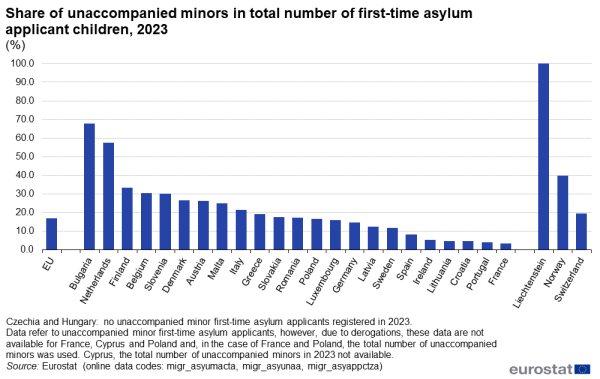
Figure 11: Share of unaccompanied minors in total number of first-time asylum applicant children, 2023
(%)
Source: Eurostat (migr_asyumacta) and (migr_asyappctza) and (migr_asyunaa)
Table 3 shows a list of the countries of citizenship with the highest number of children aged less than 18 years being unaccompanied minors applying for asylum for the first time in the EU in 2023. The 20 countries shown consisted of one European country, six Asian countries, eleven African countries, Venezuela and Colombia from South America.
The most represented citizenships of unaccompanied minor first-time asylum applicants in the EU in 2023 were Syrians and Afghans.
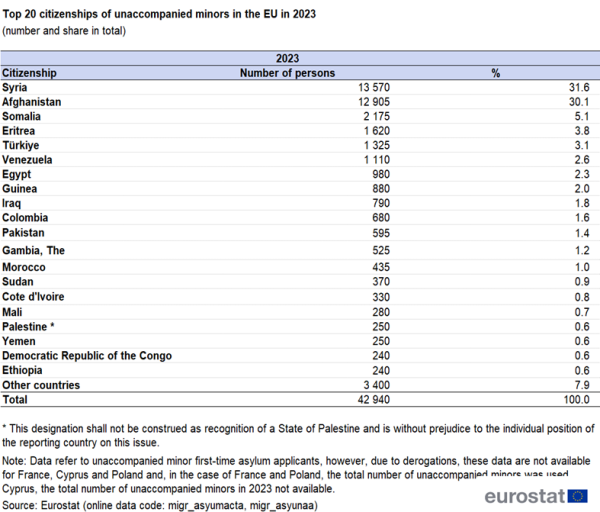
Table 3: Top 20 citizenships of unaccompanied minors in 2023
(number and share in total)
Source: Eurostat (migr_asyumacta) and (migr_asyunaa)
Decisions on asylum application for children
As Figure 12 shows, the ratio between the total number of positive decisions and the total number of decisions either at first instance or on appeal was higher over the period 2013 to 2023 for first-time asylum applicant children than for adult first-time asylum applicants. This difference was more significant for first instance decisions than for decisions taken in appeal. It means that the first instance acceptance rate for children is 1.4 times higher than for adults, while for the final decisions on appeal, the acceptance rate for children is 1.2 times higher than for adults.

Figure 12: Share of the positive decisions on asylum applications in the EU at first instance and for final decisions in appeal over the 2013-2023 period
(%)
Source: Eurostat (migr_asydcfsta) and (migr_asydcfina)
Figure 13 suggests that the asylum procedure is faster for children than for adults, since the share of children in the total number of pending applications is always lower than the share of children in the total number of first-time asylum applicants. The difference between the two shares is not constant, and it reached its lowest in 2015 at the beginning of the migration crisis, reflecting the pressure at that time on the asylum systems in the EU.
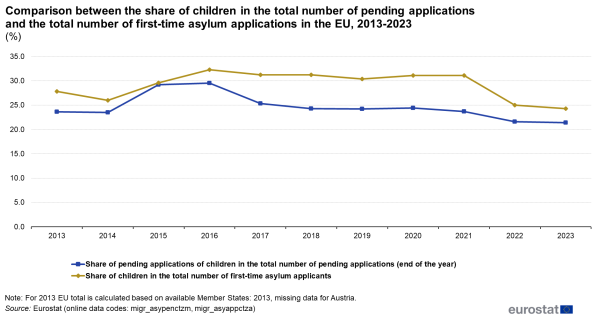
Figure 13: Comparison between the share of children in the total number of pending applications and the total number of first-time asylum applications in the EU, 2013-2023
(%)
Source: Eurostat (migr_asypenctzm) and (migr_asyappctza)
Decisions granting temporary protection to children fleeing Ukraine
On 4 March 2022, the European Council unanimously adopted an implementing decision introducing temporary protection for people fleeing Ukraine as a consequence of Russia's invasion. Temporary protection[1] is an exceptional measure to provide immediate and temporary protection to displaced persons from non-EU countries and those unable to return to their country of origin. It applies when there is a risk that the standard asylum system will struggle to cope with demands stemming from a mass inflow, risking a negative impact on the processing of claims.
On 31 December 2023, based on available data, about 1.4 million children (non-EU citizens), who had fled Ukraine as a consequence of the Russian invasion in 2022, were under temporary protection in the EU. Poland reported a total of 421 140 children who benefited from decisions granting temporary protection. Germany (381 165 beneficiaries) and Czechia (96 535) were the other EU countries with the highest total numbers of child beneficiaries of temporary protection.
As Figure 14 shows, Poland (44.1 %) recorded the highest share of children in the total number of non-EU citizens benefitting from decisions granting temporary protection on 31 December 2023, followed at some distance by Lithuania (34.0 %), Bulgaria (33.8 %) and Italy (33.4 %). At EU level, the share was 32.5 %.
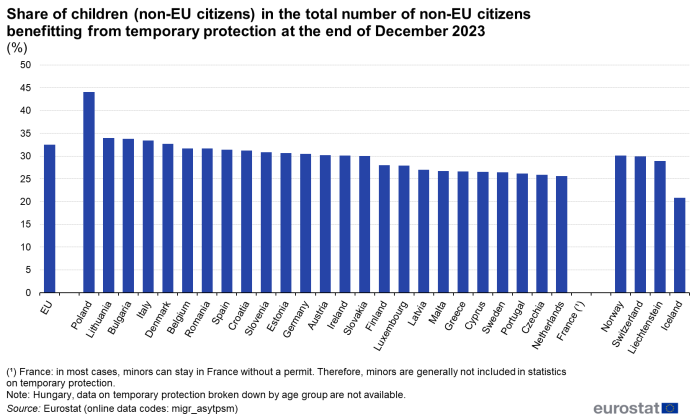
(%)
Source: Eurostat (migr_asytpsm)
Detailed analysis of temporary protection statistics can be consulted in the more comprehensive monthly Statistics Explained article.
Source data for tables and graphs
Data sources
Asylum statistics
Since 2008 data have been provided to Eurostat under the provisions of Article 4 of the Regulation (EC) No 862/2007; most of the statistics presented in this article were collected within this regulatory framework. Data are provided to Eurostat with a monthly frequency (for asylum application statistics), quarterly frequency (for first instance decisions) or annual frequency (for final decisions based on appeal or review, resettlement and unaccompanied minors). The statistics are based on administrative sources and are supplied to Eurostat by statistical authorities, home office ministries/ministries of the interior or related immigration agencies in the EU countries.
Methodological notes
1) The EU total is calculated as the aggregation of the available Member States data.
- 2013: missing data for Austria.
- 2013-2020: total number of unaccompanied minors was used in the calculations.
- 2021-2023: data refer to unaccompanied minor first-time asylum applicants, however, due to derogations, these data are not available for France, Cyprus and Poland and, in this case, these three EU countries were excluded from the calculations.
Data on temporary protection
- France: In most cases, minors can stay in France without a permit. Therefore, minors are generally not included in statistics on temporary protection.
- Hungary: data on temporary protection broken down by age group are not available.
2) Member State data refer to the number of persons applying for asylum for the first time in that Member State. Persons may however apply for international protection in more than one Member State in a given reference year. Consequently, the EU total may include such multiple applications.
Context
In recent years, the number of children in migration[2] arriving in the European Union, many of whom are unaccompanied, has increased in a dramatic way, particularly in 2015 and 2016.
Protecting children is first and foremost about upholding European values of respect for human rights, dignity and solidarity. This is why protecting all children in migration, regardless of status and at all stages of migration, is a priority. The European Union, together with its Member States and with the support of the relevant EU agencies (European Border and Coast Guard Agency; European Asylum Support Office (EASO) and the European Union Agency for Fundamental Rights (FRA)), has been active on this front for many years. The existing EU policies and legislation provide a solid framework for the protection of the rights of the child in migration covering all aspects including reception conditions, the treatment of their applications and integration.
The protection of children in migration starts by addressing the root causes which lead so many of them to embark on perilous journeys to Europe. This means addressing the persistence of violent and often protracted conflicts, forced displacements, inequalities in living standards, limited economic opportunities and access to basic services through sustained efforts to eradicate poverty and deprivation and to develop integrated child protection systems in third countries. The European Union and its Member States have stepped up their efforts to establish a comprehensive external policy framework to reinforce cooperation with partner countries in mainstreaming child protection at global, regional and bilateral levels. The European Union is fully committed to implement the 2030 Agenda for Sustainable Development, which calls for a world in which every child grows up free from violence and exploitation, has his/her rights protected and access to quality education and healthcare. The 2015 Valletta Summit [3] political declaration and its Action Plan calls for the prevention of and fight against irregular migration, migrant smuggling and trafficking in human beings (with a specific focus on women and children).
The EU Guidelines on the Promotion and Protection of the Rights of the Child renew the EU's commitment to promote and protect the indivisibility of the rights of the child in its relations with third countries, including countries of origin or transit. In this context, the Council reaffirmed the need to protect all refugee and migrant children, regardless of their status, and give primary consideration at all times to the best interests of the child, including unaccompanied children and those separated from their families, in full compliance with the UN Convention on the Rights of the Child and its Optional Protocols.
Within the European Commission, the Directorate-General for Migration and Home Affairs is responsible for immigration policy, whereas the Directorate-General for Justice and Consumers is in charge of child policy. All relevant legal acts and information regarding the EU’s immigration policy can be accessed on the European Commission’s website. Readers interested in the recent development of the global immigration policy in the European Union can also refer to the new pact on migration and asylum which has been presented by the European Commission in September 2020.
Direct access to
Notes
- ↑ Temporary protection status and conditions of applications are defined by Council Directive 2001/55/EC of 20 July 2001, whereas Council Decision 2022/382 of 4 March 2022, establishing the existence of a mass influx of displaced persons from Ukraine within the meaning of Article 5 of Directive 2001/55/EC, is the first one to introduce temporary protection.
- ↑ The terms ‘children in migration’, or ‘children’, in this document cover all third country national children (persons below 18 years old) who are forcibly displaced or migrate to and within the EU territory, be it with their (extended) family, with a non-family member (separated children) or alone, whether or not seeking asylum.
- ↑ https://www.consilium.europa.eu/media/21839/action_plan_en.pdf